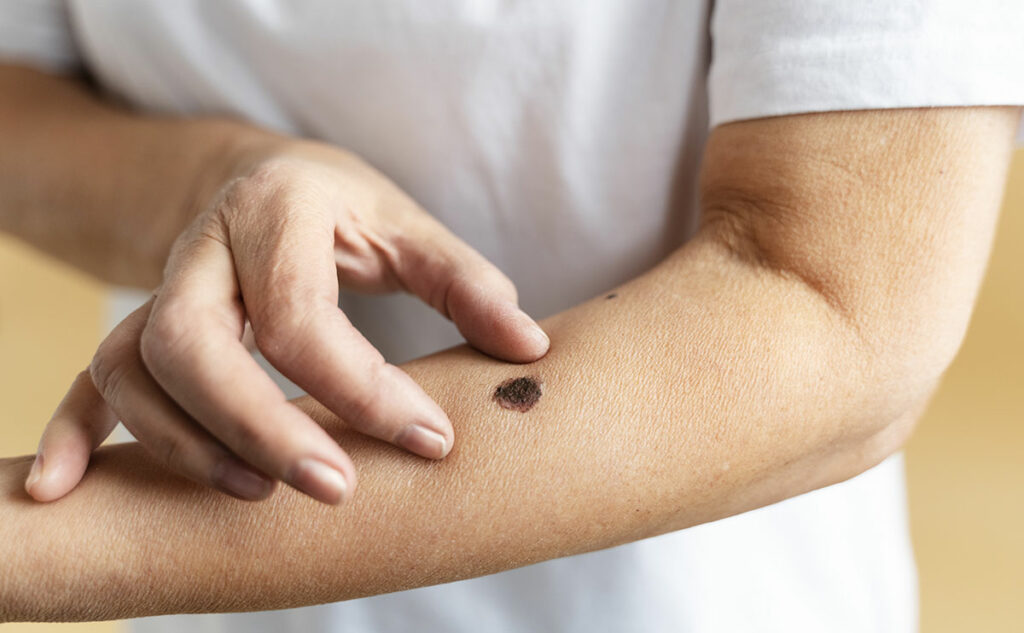
Melanoma is a form of skin cancer that begins in melanocytes, the cells responsible for producing pigment. These cells produce melanin, the pigment that gives skin, hair, and eyes its color. Melanoma is known for its potential to spread or metastasize to other parts of the body, making early detection and treatment crucial.
- Does family history affect melanoma?
- Do genetics play a role in melanoma?
- What is the highest risk factor for melanoma?
- What genes are inherited in melanoma?
- What is the best predictor of melanoma prognosis?
Does family history affect melanoma?
Contrary to popular belief, only a small percentage of people, approximately 1% to 2%, diagnosed with melanoma have a family history of the disease. Melanoma is primarily sporadic, meaning it occurs by chance rather than being inherited. Understanding the genetic aspects of melanoma is crucial to clarify misconceptions.
However, there is a noteworthy exception. When two or more first-degree relatives have melanoma, the risk for an individual to develop it increases significantly—ranging from 30 to 70 times higher than those without a family history.
Do genetics play a role in melanoma?
Melanoma, also known as cutaneous melanoma, is a relatively rare form of skin cancer.
While most cases are not inherited, 5% to 10% of melanomas arise in multiple-case families and are inherited in an autosomal dominant fashion.
It's crucial to note that melanoma, being the most lethal among common skin cancers, can result from gene mutations inherited in about 10% of cases.
However, the primary causes of most melanomas are exposure to UV rays from the sun, tanning beds, and tanning lamps, which are known to harm the skin.
What is the highest risk factor for melanoma?
Exposure to ultraviolet (UV) rays, originating mainly from sunlight, tanning beds, and sun lamps, poses a significant risk for melanoma development. Despite UV rays comprising a small fraction of the sun's overall rays, they are the primary culprit behind the damaging effects on the skin.
Both natural and artificial exposure to UV light are recognized as the leading risk factors for melanoma, with the risk escalating in proportion to the duration and intensity of exposure.
It's noteworthy that more than 90 percent of skin cancers, including melanoma, are attributed to sun exposure.
What genes are inherited in melanoma?
The risk of melanoma can be hereditary, passing from one generation to the next within families.
Two key genes associated with familial melanoma, CDKN2A and CDK4, have been identified. A mutation in either of these genes increases an individual's susceptibility to melanoma.
The most prevalent genetic alteration in melanoma cells involves the BRAF oncogene, detected in approximately half of all melanomas. Additional genes like NRAS, CDKN2A, and NF1 may also be implicated, with usually only one of them being affected.
In around 50% of meningiomas, mutations in the tumor suppressor gene neurofibromin 2 (NF2) are responsible for the development of these tumors.
What is the best predictor of melanoma prognosis?
The prognosis of melanoma is significantly influenced by the thickness of the primary tumor, a crucial prognostic factor that aids in predicting the likelihood of cancer spreading.
Breslow's depth, measured microscopically as the thickness from the granular cell layer in the epidermis to the deepest malignant cell, holds particular importance.
Generally, a thicker tumor is associated with a poorer prognosis, indicating a higher risk of metastasis.
Breslow's depth serves as a key metric for healthcare professionals in assessing and determining the prognosis of individuals with melanoma, guiding treatment decisions and care plans.
Genetic testing may be recommended for individuals with a strong family history of melanoma or those with multiple atypical moles.
Testing typically involves analyzing specific genes, such as CDKN2A and CDK4, to identify mutations that may increase the risk of melanoma.
Counseling and Management:
Genetic counseling is often recommended before and after genetic testing to help individuals understand the implications of their results and make informed decisions.
Individuals having a genetic predisposition may undergo increased surveillance, including more frequent skin exams and other preventive measures.
Summary
Regular self-examinations and professional skin checks are essential for early detection, especially for individuals with risk factors. If there are concerns about skin changes or potential melanoma, consulting with a dermatologist is advised.
References
- Mayoclinic.org Melanoma - An overview
- Cancer.net Familial Malignant Melanoma
- National Cancer Institute - Genetics of Skin Cancer -Health Professional Version
- Curemelanoma.org How Genetics and Family History Contribute to Melanoma Risk

